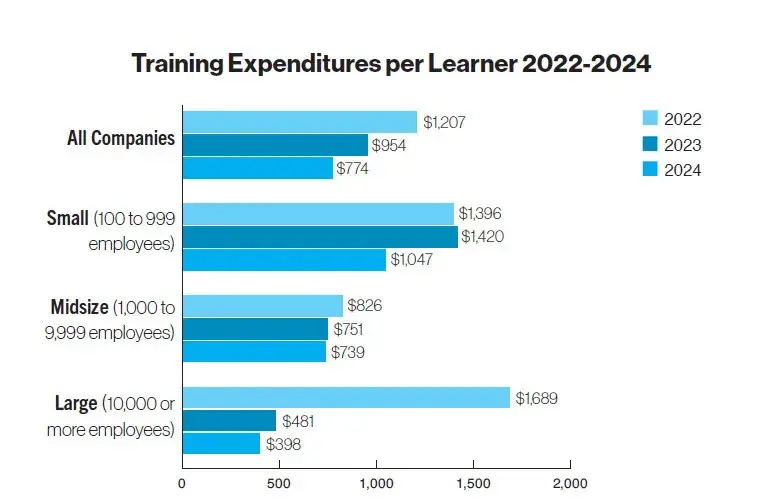Table of Contents
A training budget is a financial plan that outlines how much an organization will invest in learning and development (L&D) over a specific period.
While it might not be as exciting as launching a new product or celebrating a milestone, preparing your training budget is a critical task that sets the foundation for your business’s success.
A well-planned budget for training and development allows you to prioritize initiatives, allocate resources efficiently, and align training efforts with your business goals. Whether upskilling employees, onboarding new hires, or educating customers, a comprehensive overall training budget that accounts for all educational initiatives will help you stay on track with your finances.
Of course, managing training budgets can feel overwhelming, with so many variables to consider. But with a thoughtful approach, you can take the guesswork out of the process. This guide will walk you through developing a training budget template to help you optimize resources, evaluate costs accurately, track expenses, and maximize return on investment (ROI).
Did you know?
On average, US companies spend $774 per learner annually, but costs vary widely by company size. Small companies spend over $1,000 per learner, while large organizations average under $400, according to Training Magazine.
First things first: Why do you need a budget for training?
A training budget is a strategic tool you can use to ensure your learning initiatives deliver real value to your organization. Whether you’re training employees or educating customers, a smart budget sets the stage for impactful programs without breaking the bank.
Creating a training budget is essential because it allows you to do the following.
Align training with business goals
Training and business goals go hand in hand, so budgeting is an essential part of your strategy. A structured budget for training ensures your programs directly support organizational priorities, such as improving performance, enhancing customer satisfaction, or scaling operations.
Prioritize resources effectively
Training budget allocation is tricky when you have multiple needs. When you identify and calculate training costs in advance, you can allocate resources more effectively to prioritize and support your most critical training needs.
Keep employees and customers engaged
A thoughtful training budget can help you offer training on a regular basis and foster a culture of continuous, lifelong learning in the workplace. Regular training, whether for employees or customers, helps participants stay informed, confident, and deeply engaged with your organization.
Demonstrate ROI and accountability
With a clear breakdown of spending and outcomes, you can track key metrics, like productivity gains, customer satisfaction, and retention rates, to prove training ROI. This transparency justifies your investment and strengthens future budget proposals.
💡Learn more: How to see a positive ROI from customer education
Minimize hidden costs and inefficiencies
Proper training budget planning reduces surprises that are too common in learning and development activities, such as trainer fees or additional software expenses. Mapping out expenses ensures you avoid costly mistakes or redundancies in training efforts.
Reduce unnecessary training costs
Having a learning and development (L&D) budget will help you project expenses more accurately and make necessary adjustments to find more cost-effective training solutions, such as choosing online courses over on-site, to reduce unnecessary expenses.
Support long-term success
A comprehensive L&D budget ensures that your initiatives are sustainable, scalable, and aligned with your overall strategy, helping your organization grow while managing costs effectively. A well-planned training budget can help you provide ongoing training to achieve your company’s goals and drive your organization forward.
By taking the time to learn how to manage a training budget, you’ll create a roadmap for impactful learning programs that drive measurable results for both your team and your customers.
How do you calculate training costs?
There are different methods to calculate the cost of training. Many companies allocate a percentage of annual salary toward learning and development. Others base their training budget on average per-employee costs, industry benchmarks, or past program spending, depending on the level of detail and data available.
Let’s say you set aside 5% of your total annual salary for training. To calculate what your training costs would look like, use:
Training budget = Total annual salary x 5%
This approach gives you a rough budget estimate and can be refined based on past outcomes, skill gaps, or strategic goals.
For organizations that need more precision, a bottom-up budgeting approach offers a detailed view of actual training costing. Instead of applying a general percentage, you break down each element of your program—tools, sessions, facilitators, software, and evaluation—and calculate costs line by line.
How much does it cost to train an employee? Benchmarks per company size
Employee training costs vary widely depending on the size of the organization. According to Training Magazine, US companies collectively spent $98 billion on training in 2024, with significant differences in investment by company size:
Despite having the lowest individual budgets, small businesses account for one-third of total training spend nationwide due to their volume in the market.
When calculating training cost per employee, company size plays a notable role:

Smaller organizations tend to spend more per person, often because they lack the scale to spread costs across a large workforce or outsource selectively.
Training budget example
To give a practical view of what goes into planning and tracking the cost of training employees, here’s a detailed training budget example focused on onboarding new hires using a bottom-up budgeting approach.
This breakdown covers various types of training and accounts for both fixed and variable costs that contribute to a successful onboarding process:
Total training cost: $9,500
How do you create a budget for a training program?
Creating a training budget requires a holistic approach that considers all aspects of your training programs, from identifying needs to evaluating impact.
Here’s how to create and manage your training budget effectively.
Step 1. Identify your training needs
Start by pinpointing knowledge or skill gaps within your organization or among your customers. Use tools like surveys, performance reviews, and customer feedback to determine priorities.
For example, employees might need upskilling to handle new tools, while customers could benefit from a structured onboarding program or advanced product training. This ensures your budget targets the most impactful areas.
Step 2. Define your objectives
Clearly articulate the purpose of your training initiatives, whether it’s addressing skill gaps, enhancing product adoption, meeting compliance requirements, or driving innovation.
Defining measurable outcomes helps focus your budget on initiatives that align with strategic business goals. Create SMART goals that you can use as benchmarks to measure the effectiveness of your programs.
Step 3. Identify your audience
Segment your learners to tailor training effectively. For employees, consider roles, departments, or seniority levels. For customers, segment by job role, subscription tier, or industry. A targeted approach ensures your training budget is spent on the right audiences.
Step 4. Choose delivery methods
Select training methods based on your audience’s preferences and content type. Options include:
Step 5. Use business budgeting software
Business budgeting software streamlines financial management and allows you to monitor your budget by tracking income and expenses, predicting training costs, and automating core tasks, such as categorizing expenses or allocating resources.
Step 6. Create a training budget template to allocate costs by key categories
Break your budget into these primary components to manage training expenses effectively and ensure you don’t leave anything out.
The following training budget template maps out the most common expenses for employee training:
Let’s do the same for customer education. Here, too, you’ll find some shared expenses across online and in-person training.
Note that in SaaS and tech, most customer education happens online. However, complex products, like enterprise CRM tools, may require in-person demonstrations and training.
In industries like healthcare and manufacturing, face-to-face training is more common because using the product incorrectly could harm the customer’s health or safety.
Step 7. Plan for scalability
Ensure your budget accommodates growth. For example, calculate the average training budget per employee to project additional costs that will occur as your team grows. Similarly, ensure customer training programs can scale as your user base grows without exponentially increasing the cost. Again, a viable solution to scale your training is to deliver it online.
Step 8. Anticipate hidden costs
Direct and indirect costs are part of the plan, and so are hidden costs. Be prepared for unexpected expenses that can occur during travel, software upgrades, or downtime during training sessions. Including a contingency fund can help address surprises without disrupting your overall budget.
Step 9. Set realistic timelines
Align training schedules with your budget allocations to prevent overspending early in the year and ensure your training programs run consistently. For example:
Step 10. Monitor and evaluate ROI
Track training costs and outcomes per training program using key performance indicators (KPIs) like:
Use analytics to refine your L&D budget and demonstrate value to stakeholders.
💡Keep learning: How to track employee training and measure ROI
Step 11. Iterate regularly
Training needs evolve, and so should your training strategy. Continuously review feedback, performance data, and business priorities to adjust your budget and align it with current needs. Regular iteration ensures your training programs remain relevant and effective.
By following these steps, you can develop a comprehensive and cost-effective training budget that aligns with your business goals and supports both employee and customer success.
Watch our on-demand webinar How to trim your training budget in 2025 to discover more actionable tips and strategies.
Make the most out of your L&D budget with LearnWorlds
A well-planned training budget is key to achieving your business goals while fostering continuous learning. An LMS can help you create cost-effective, scalable training programs, streamline processes, and maximize your resources.
By centralizing content, automating tasks, and tracking outcomes, you can reduce costs and ensure every dollar spent delivers value. Start budgeting smarter today and empower your team and customers for lasting success.
Want to see cost-effective training in action? Sign up for your 30-day free trial today and discover our feature-rich LMS.

Androniki Koumadoraki
Androniki is a Content Writer at LearnWorlds sharing Instructional Design and marketing tips. With solid experience in B2B writing and technical translation, she is passionate about learning and spreading knowledge. She is also an aspiring yogi, a book nerd, and a talented transponster.




